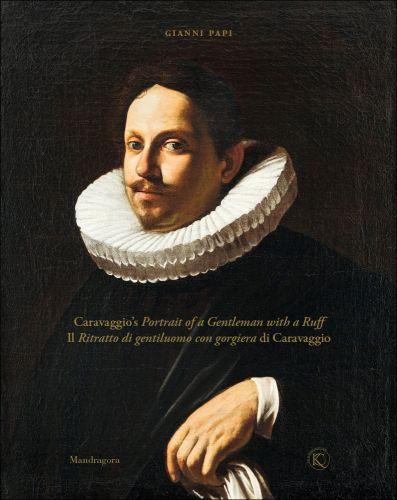
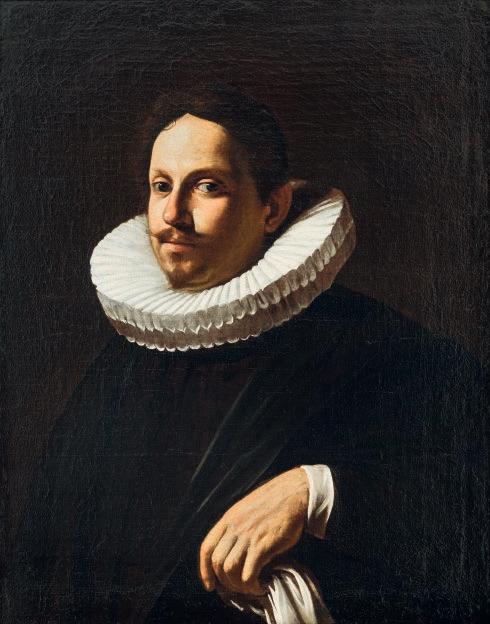
Caravaggio’s Portrait of a Gentleman with a Ruff
Caravaggio’s Portrait of a Gentleman with a Ruff (fig. 1), which is a recent arrival in the Klesch Collection, has a short critical history. It also has a very limited history as regards the associated bibliography and media coverage, perhaps because the painting came to the fore prior to the social media explosion characteristic of recent years and, above all, at a time when today’s almost obsessive interest in Caravaggio was certainly not so developed. This interest has since expanded to incorporate all levels of communication, even the most widely popular. When the Portrait first came to people’s attention, the Florentine exhibition in Palazzo Pitti curated by Mina Gregori between the end of 1991 and 1992 (which, in my opinion, marks the real turning point in the exponential growth in general enthusiasm for the painter) had concluded, 1 and its Roman continuation in Palazzo Ruspoli was drawing to a close.2 Today, an appearance such as that would certainly have resonated on a completely different level, but in 1992, Caravaggio’s following was far removed from what it is today, despite the fact that the artist already exerted an appeal that few other painters could boast at the time.
The painting in question first appeared on 22 May 1992 at a Sotheby’s auction in New York as attributed to Battistello Caracciolo (lot 193). On that occasion the work was purchased, without particular clamour, by the antiquarian Marco Voena, who, after cleaning the canvas and realising its importance, showed it to Mina Gregori. The scholar confirmed
Il Ritratto di gentiluomo con gorgiera di Caravaggio
Il Ritratto di gentiluomo con gorgiera di Caravaggio (fig. 1), entrata in tempi recenti nella Klesch collection, ha, sul piano critico, una storia breve. Una storia molto contenuta anche sul piano bibliografico, oltreché su quello mediatico, forse perché il dipinto venne alla ribalta in un tempo precedente alle esplosioni social caratteristiche di questi ultimi anni e soprattutto in un tempo dove l’interesse odierno, quasi ossessivo, per Caravaggio non era certo così sviluppato: un interesse spinto ormai a tutti i livelli di comunicazione, anche i più largamente divulgativi. Quando il Ritratto compariva alla ribalta, la mostra fiorentina di Palazzo Pitti curata da Mina Gregori fra la fine del 1991 e il 1992 (vero punto di svolta a mio parere della crescita esponenziale della passione generalizzata per il pittore) era terminata, 1 ed erano gli ultimi giorni della sua prosecuzione romana a Palazzo Ruspoli.2 Oggi sicuramente quella comparsa avrebbe tutt’altra risonanza, ma nel 1992 si era ben distanti dal culto attuale, sebbene Caravaggio avesse già allora un appeal che pochi altri pittori potevano vantare.
Il dipinto infatti appare per la prima volta in asta Sotheby’s a New York col riferimento a Battistello Caracciolo il 22 maggio 1992 (lotto 193). In quella occasione l’opera fu acquistata, senza particolare clamore, dall’antiquario Marco Voena, il quale, dopo aver fatto pulire la tela e averne compreso l’importanza, la mostrò a Mina Gregori. La studiosa confermò l’autografia di Merisi e pubblicò il dipinto sotto tale paternità già una prima volta nel 1994.3
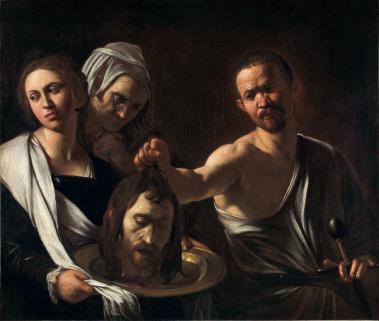
Maffeo Barberini and in the gaze of Salome in the eponymous painting in the National Gallery in London (figs. 11, 13). In the latter’s gaze, that horizontal filament of lead white that crosses the outer part of the iris, also identical in the Klesch Portrait, is used by the painter – with a prodigious confidence of touch and certainty regarding the effect to be achieved – to give brightness and vividness to the eyes.
Another typical feature of Caravaggio’s work is the shape of the nose with the straight ridge rounding off towards the tip. Once again, the comparison is convincing, for example, with the aforementioned Salome, but also with Pero from the Seven Acts of Mercy (figs. 12, 14). In the latter’s face, one can also find very similar construction features (particularly in the brushstrokes that build up the surface of the cheeks), as well as, once again, that characteristic three-quarter gaze, with the eyes slightly off-set.
di biacca che attraversa la parte esterna dell’iride, identico anche nel nostro Ritratto, utilizzato dal pittore – con una prodigiosa sicurezza di tocco e certezza dell’effetto che si vuole raggiungere – per dare luminosità e vivezza agli occhi.
Tipica di Caravaggio è poi la forma del naso con la canna dritta che si arrotonda verso la punta: ancora una volta il confronto è probante, ad esempio, con la suddetta Salomè, ma anche con la Pero delle Sette opere di Misericordia (figg. 12, 14). In quest’ultimo volto si potranno poi ritrovare caratteristiche costruttive davvero simili (in particolare nelle pennellate che costruiscono la superficie delle guance), nonché, ancora una volta, quel caratteristico sguardo di tre quarti, con gli occhi leggermente disassati.
Quanto alla conduzione della mano del nostro Gentiluomo, realizzata con pochissimi tocchi di pennello, utilizzando, per le ombre, la preparazione bruno-rossastra, essa

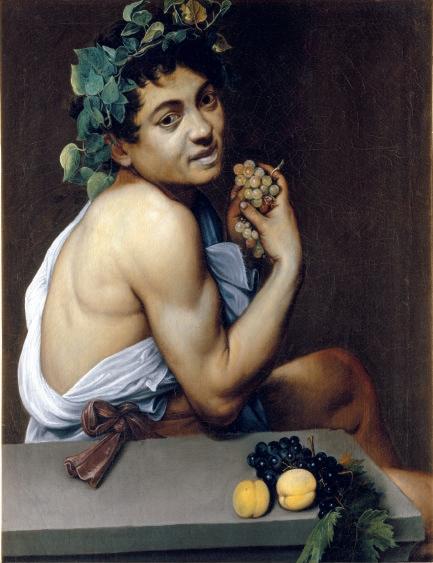
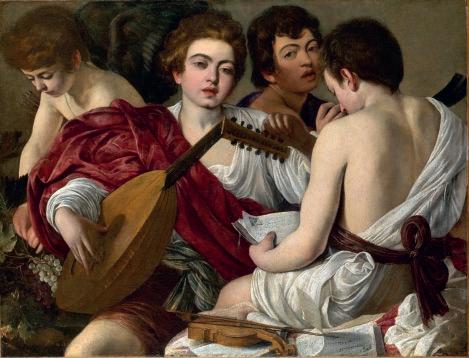
Goliath in the Borghese David, probably painted in 1606 in Zagarolo, immediately after his flight from Rome (fig. 19). It seems likely that Caravaggio also depicted himself in the sorrowful St Francis in Meditation in the Museo di Cremona.
Another model can also be identified through records. We know – from the diary of Richard Symonds, an English traveller to Rome in 165049 – that it was the very young Francesco Boneri, the apprentice and later famous painter (better known as Cecco del Caravaggio) who posed for the Love Triumphant (fig. 20), now in the Gemäldegalerie in Berlin. He was probably Caravaggio’s companion for some
a Zagarolo, subito dopo la fuga da Roma (fig. 19). E con probabilità ancora Caravaggio si rappresenta nel dolente San Francesco penitente del Museo di Cremona.
Anche un altro modello è identificabile anagraficamente. Sappiamo – dal diario di Richard Symonds, viaggiatore inglese a Roma nel 165049 – che a posare per l’Amore vincitore (fig. 20) oggi presso la Gemäldegalerie di Berlino fu il giovanissimo Francesco Boneri, l’apprendista e poi celebre pittore (meglio noto come Cecco del Caravaggio), che verosimilmente fu il compagno di Merisi per alcuni anni fra il 1600 e il 1606/1607 e che nel 1605 è documentato risiedere insieme a lui nella casa
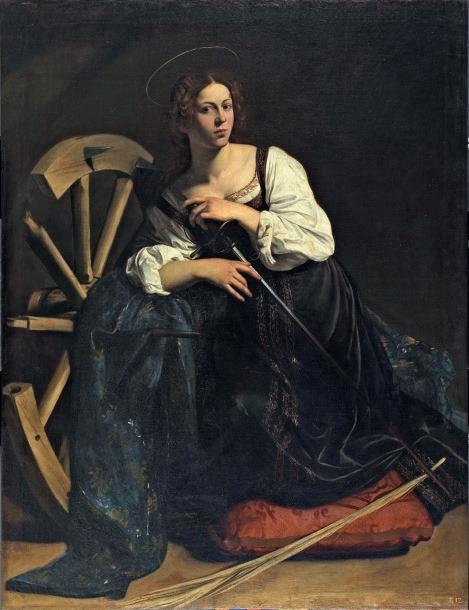

In his Considerations on Painting, Giulio Mancini mentions a portrait, painted during Caravaggio’s first months in Rome, which portrayed ‘a host’ with whom ‘he sought refuge’.54 Also in his life of Caravaggio, Mancini mentions the ‘portrait of a villager’ that has sometimes been linked to the Boy with a Basket of Fruit now in the Galleria Borghese.55
The Portrait of Cardinal Serafino Olivier Razzali from Lyon, who became a cardinal on 9 June 1604 (so the painting must have been executed between the second half of 1604 and the first half of 1606), is mentioned in a sonnet by Marzio Milesi entitled ‘Per lo ritratto del Cardinal Serafino / Fatto da Michel Angiol da Caravaggio’ (‘For the portrait of Cardinal Serafino / Made by Michel Angiol da Caravaggio’).56
quale «si ricoverava».54 Mancini ricorda, sempre nella vita di Caravaggio, il «ritratto di un villico» che talvolta è stato collegato al Ragazzo con canestro di frutta oggi alla Galleria Borghese.55
Il Ritratto del cardinale Serafino Olivier Razzali di Lione, asceso alla porpora cardinalizia il 9 giugno 1604 (quindi il dipinto sarà stato eseguito fra la seconda metà del 1604 e la prima metà del 1606), viene citato in un sonetto di Marzio Milesi che ha proprio come titolo «Per lo ritratto del Cardinal Serafino / Fatto da Michel Angiol da Caravaggio».56
Un sonetto della Galeria di Giovambattista Marino ha per tema un ritratto del poeta eseguito da Caravaggio: «Sopra il proprio ritratto dell’Autore di mano di Michelangelo
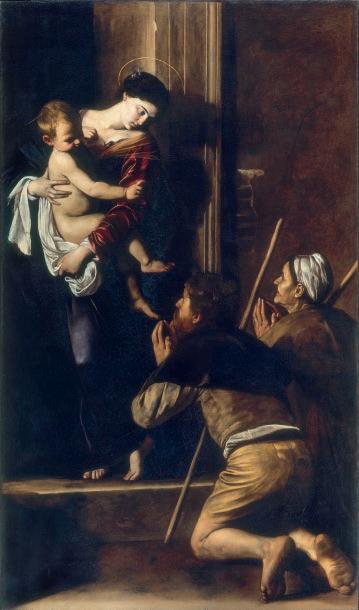
A sonnet from Giovambattista Marino’s Galeria is about a portrait of the poet by Caravaggio: ‘Sopra il proprio ritratto dell’Autore di mano di Michelangelo da Caravaggio’ (‘On the portrait of the Author by the hand of Michelangelo da Caravaggio’).57 Marino’s portrait is also mentioned by Bellori: ‘Caravaggio had painted a portrait of Cavalier Marino’.58 Maurizio Marini proposed identifying it with a painting in a private collection depicting a young man.59 This suggestion met with little response, but was accepted in the monograph by Sebastian Schütze, who agreed on both the attribution and the identification of the sitter.60
The Giustiniani Inventory of 1638 mentions three portraits that are currently unaccounted for: ‘A painting with a portrait of a Lombard Matron with a white veil on her head and her name written Marsilia Sicca painted on canvas, 2 spans high, approx. 2 spans wide [in the early manner of Michelangelo da Caravaggio, it is believed]’ and ‘A half-figure painting of a famous Courtesan still unperfect painted on canvas, 4.5 spans high, approx. 3.5 spans wide [by Michelangelo da Caravaggio] with its black frame’.61 Also present was ‘A portrait of the Criminalist Farinaccio painted in tela da testa [by the hand, it is believed, of Michelangelo da Caravaggio] with walnut frame’,62 which has recently been linked (without further critical confirmation) to a painting in a private collection in the UK.63
Costanzo Patrizi’s 1624 inventory records ‘A painting of the portrait of Bernardino Cesari by the hand of Caravaggio, with a gold frame, twenty-five scudi, 25’.64 It should be noted that the inventory was drawn up by Giuseppe Cesari (the Cavalier d’Arpino), who was Bernardino’s brother, so the information is probably very accurate.
Caterina Campani’s will, written in July 1652, includes a ‘portrait on canvas of Mr Honorio Longo, a painting by Michelangelo Merisio da Caravaggio with a fully gilded frame … and another portrait of Mrs Catherina Campani, testatrix, in another pendant head with a similar pearwood frame, a painting by Michelangelo Merisio da Caravaggio’.65
Caterina Campani was the wife of Onorio Longhi, who was a great friend of the artist. The will of the couple’s son, Martino
da Caravaggio».57 Il ritratto di Marino viene ricordato anche da Bellori: «Aveva il Caravaggio fatto il ritratto del cavalier Marino».58 Maurizio Marini59 ha proposto di identificarlo con un dipinto in collezione privata che raffigura un giovane uomo. La proposta ha avuto scarsi riscontri, ma viene accettata nella monografia di Sebastian Schütze, che concorda sia sull’attribuzione che sull’identificazione del ritrattato.60
Nell’Inventario Giustiniani del 1638 sono citati tre ritratti al momento non pervenuti: «Un quadro con ritratto d’una Matrona Lombarda con un velo bianco in testa e suo nome scritto Marsilia Sicca dipinta in tela alta palmi 2. Larga 2 incirca [della prima maniera di Michelangelo da Caravaggio si crede]» e «Un quadro d’una mezza figura ritratto d’una Cortigiana famosa dipinto in tela ancora imperfetto alto palmi 4 ½. Largo 3 ½ incirca [di mano di Michelangelo da Caravaggio] con sua cornice negra».61 Inoltre era presente «Un quadro con il ritratto del Farinaccio Criminalista depinto in tela da testa [di mano, si crede, di Michelangelo da Caravaggio] con cornice di noce».62 che è stato recentemente collegato (senza ulteriori conferme critiche) a un dipinto in collezione privata nel Regno Unito.63
Nell’inventario del 1624 di Costanzo Patrizi, viene registrato «Un quadro del ritratto di Bernardino Cesari mano del Caravaggio, con cornice tocca d’oro, scudi venticinque, 25».64 Da rilevare che l’inventario fu stilato da Giuseppe Cesari (il Cavalier d’Arpino), cioè il fratello di Bernardino, perciò la notizia è verosimilmente molto precisa.
Nel testamento di Caterina Campani, redatto nel luglio del 1652, figura un «ritratto in tela del sig. Honorio Longo, pittura di Michelangelo Merisio da Caravaggio con un cornicione tutto dorato … e un altro ritratto della signora Catherina Campani testatrice in un’altra testa compagna con cornice simile di pero, pittura di Michelangelo Merisio da Caravaggio».65 Caterina Campani era la moglie di Onorio Longhi, che fu grande amico di Merisi. Nel testamento del figlio della coppia, Martino Longhi, redatto nelle date 31 luglio 1656-5 gennaio 1657, oltre ai ritratti dei genitori, si legge anche di una tela “da testa”, raffigurante «un parlatore togato pittura del Caravaggio».66
